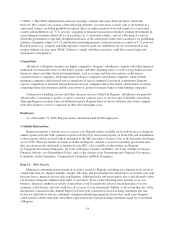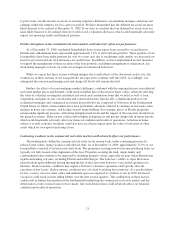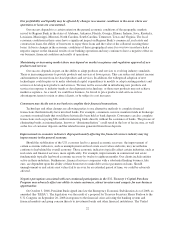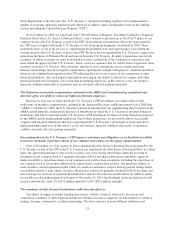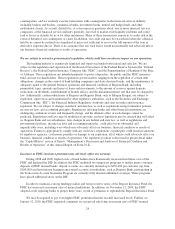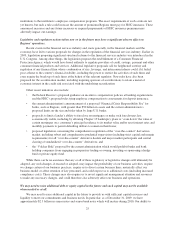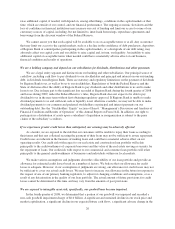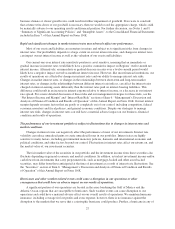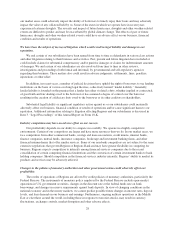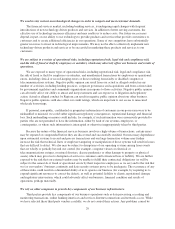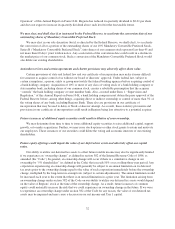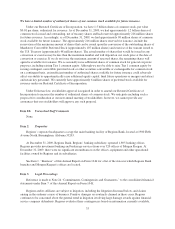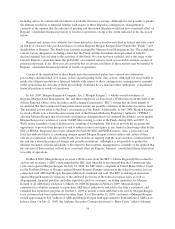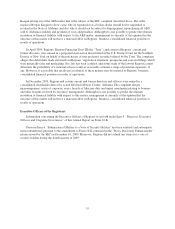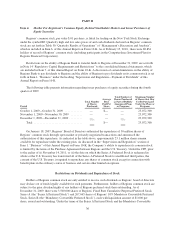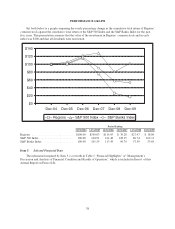Regions Bank 2009 Annual Report Download - page 42
Download and view the complete annual report
Please find page 42 of the 2009 Regions Bank annual report below. You can navigate through the pages in the report by either clicking on the pages listed below, or by using the keyword search tool below to find specific information within the annual report.our market areas could adversely impact the ability of borrowers to timely repay their loans and may adversely
impact the value of any collateral held by us. Some of the states in which we operate have in recent years
experienced extreme droughts. The severity and impact of future hurricanes, droughts and other weather-related
events are difficult to predict and may be exacerbated by global climate change. The effects of past or future
hurricanes, droughts and other weather-related events could have an adverse effect on our business, financial
condition and results of operations.
We have been the subject of increased litigation which could result in legal liability and damage to our
reputation.
We and certain of our subsidiaries have been named from time to time as defendants in various class actions
and other litigation relating to their business and activities. Past, present and future litigation have included or
could include claims for substantial compensatory and/or punitive damages or claims for indeterminate amounts
of damages. We and certain of our subsidiaries are also involved from time to time in other reviews,
investigations and proceedings (both formal and informal) by governmental and self-regulatory agencies
regarding their business. These matters also could result in adverse judgments, settlements, fines, penalties,
injunctions or other relief.
In addition, in recent years, a number of judicial decisions have upheld the right of borrowers to sue lending
institutions on the basis of various evolving legal theories, collectively termed “lender liability.” Generally,
lender liability is founded on the premise that a lender has either violated a duty, whether implied or contractual,
of good faith and fair dealing owed to the borrower or has assumed a degree of control over the borrower
resulting in the creation of a fiduciary duty owed to the borrower or its other creditors or shareholders.
Substantial legal liability or significant regulatory action against us or our subsidiaries could materially
adversely affect our business, financial condition or results of operations and/or cause significant harm to our
reputation. Additional information relating to litigation affecting Regions and our subsidiaries is discussed in
Item 3. “Legal Proceedings” of this Annual Report on Form 10-K.
Industry competition may have an adverse effect on our success.
Our profitability depends on our ability to compete successfully. We operate in a highly competitive
environment. Certain of our competitors are larger and have more resources than we do. In our market areas, we
face competition from other commercial banks, savings and loan associations, credit unions, internet banks,
finance companies, mutual funds, insurance companies, brokerage and investment banking firms, and other
financial intermediaries that offer similar services. Some of our non-bank competitors are not subject to the same
extensive regulations that govern Regions or Regions Bank and may have greater flexibility in competing for
business. Regions expects competition to intensify among financial services companies due to the recent
consolidation of certain competing financial institutions and the conversion of certain investment banks to bank
holding companies. Should competition in the financial services industry intensify, Regions’ ability to market its
products and services may be adversely affected.
Changes in the policies of monetary authorities and other government action could adversely affect our
profitability.
The results of operations of Regions are affected by credit policies of monetary authorities, particularly the
Federal Reserve. The instruments of monetary policy employed by the Federal Reserve include open-market
operations in U.S. government securities, changes in the discount rate or the federal funds rate on bank
borrowings, and changes in reserve requirements against bank deposits. In view of changing conditions in the
national economy and in the money markets, we cannot predict possible future changes in interest rates, deposit
levels, and loan demand on our business and earnings. Furthermore, ongoing military operations in the Middle
East or elsewhere around the world, including those in response to terrorist attacks, may result in currency
fluctuations, exchange controls, market disruption and other adverse effects.
28


